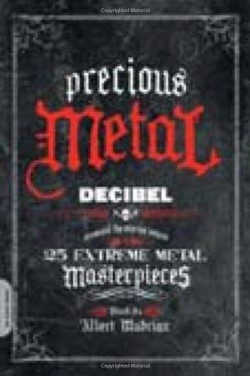Precious Metal
Stories Behind 26 Extreme Metal Masterpieces
“I don’t know why I thought of using Gustav Holst’s ‘Mars’ as an intro. I just thought it would make a great start. It’s dramatic. It draws you in.” So began the creation of Diamond Head’s single Am I Evil?, made famous in the mid-1980s by metal super-group Metallica. Statements like these fill Precious Metal, Decibel magazine Editor-in-chief Albert Mudrian’s effort to interview the bands behind some of the most influential metal albums. He only selects bands whose original members are all available, a criterion which ultimately leaves out many worthy bands. Despite this glitch, Mudrian manages to collect some important interviews from a variety of artists in the United States and Europe.
Heavy metal has gone through many metamorphoses since godfathers Black Sabbath and Led Zeppelin hit the stage in the late ’60s. Changes in heavy metal encompass virtually every type of heavy rock: Mainstream, Underground, Thrash, Death, Black, Power, Doom, and Gothic metal. What manifests in this collection is the universal common ground between musicians, regardless of genre.
Most of the musicians interviewed did not know how to read music. They were, however, interested in incorporating various orchestral instruments, as well as melodic harmonies, into their song writing. Writing songs incorporating violins or operatic vocalists is not what most of us expect from heavy metal bands. Through Mudrian’s work, we learn that musicians in like Napalm Death, Cannibal Corpse, Eyehategod, and Obituary were normal kids who loved a certain style of music. They weren’t the satanic worshipers many would like to believe they were.
The median age of these rockers draws attention. The musician quoted above was a nineteen-year-old from England. Most of these artists were only twenty or twenty-one when they were creating these significant albums. They display an impressive level of professionalism and creativity. No heavy metal story, of course, would be complete without drinking, drugs, sex, and bickering—the necessary evils of rock and roll. Mudrian never loses focus, however, and the true story behind creating these masterpieces is thoroughly documented.
This is not an academic attempt by any stretch of the imagination, but fans of this musical genre will undoubtedly enjoy reading how their favorite metal albums were constructed.
Disclosure: This article is not an endorsement, but a review. The publisher of this book provided free copies of the book to have their book reviewed by a professional reviewer. No fee was paid by the publisher for this review. Foreword Reviews only recommends books that we love. Foreword Magazine, Inc. is disclosing this in accordance with the Federal Trade Commission’s 16 CFR, Part 255.

